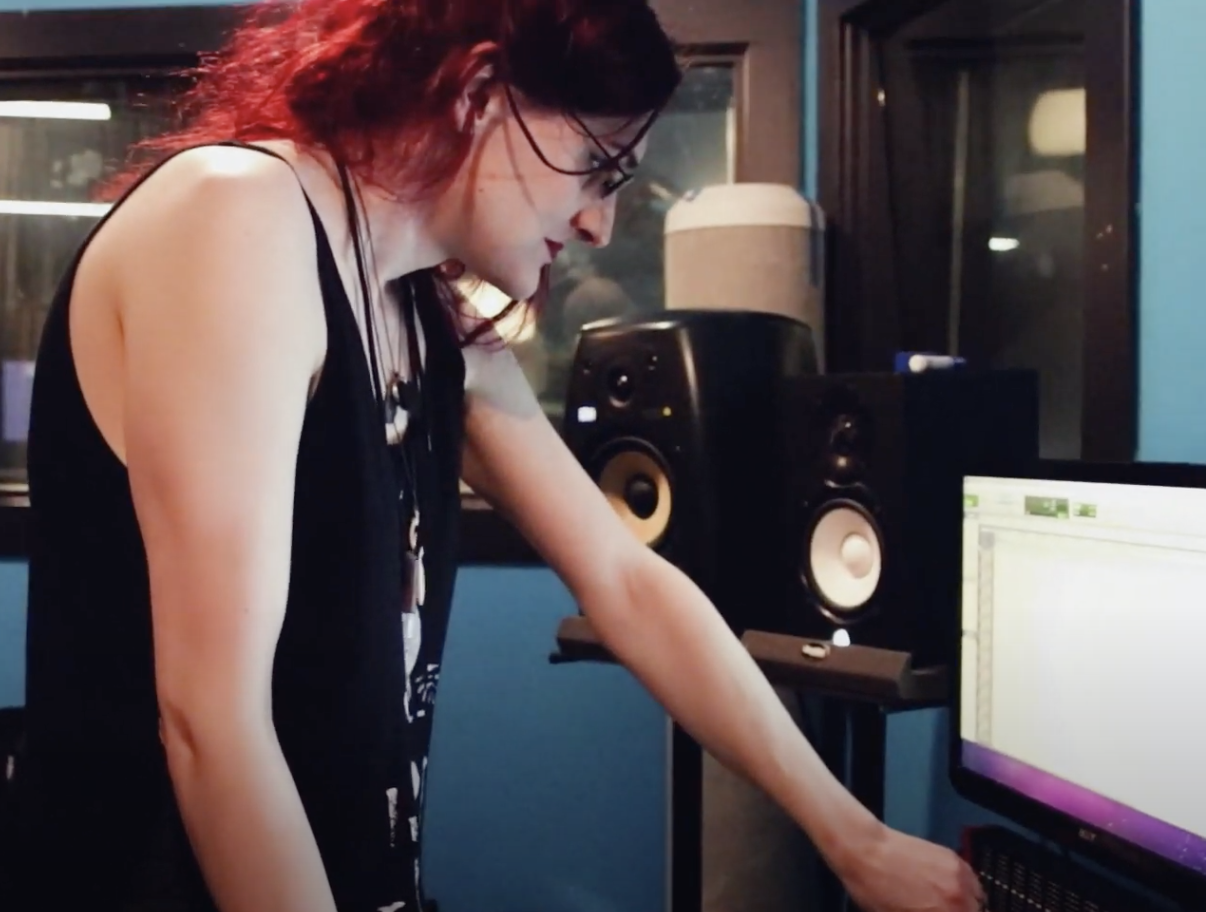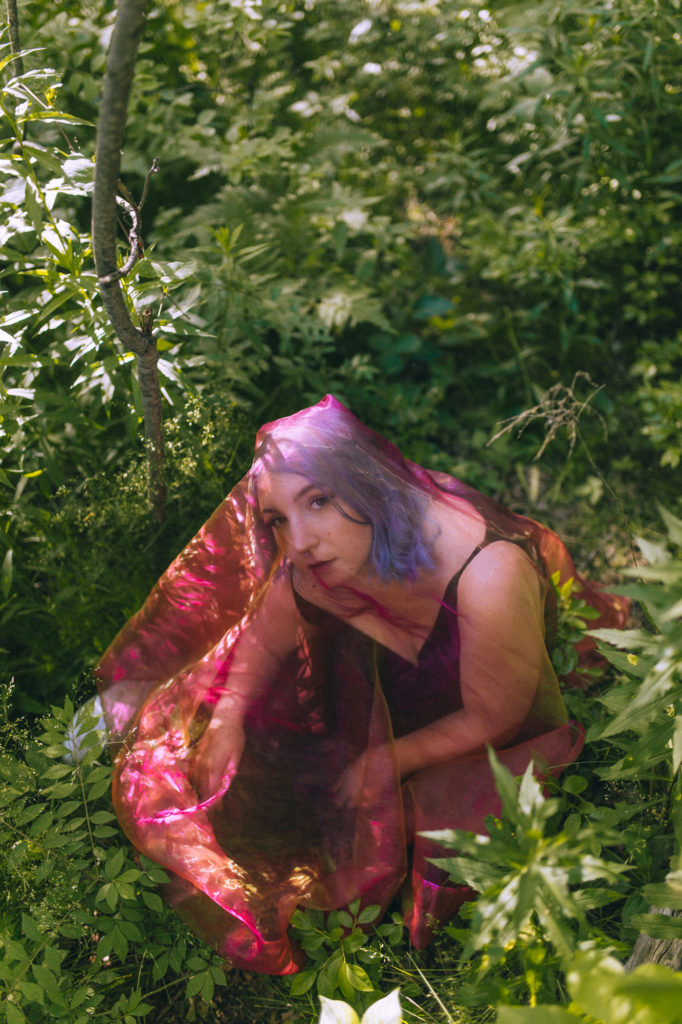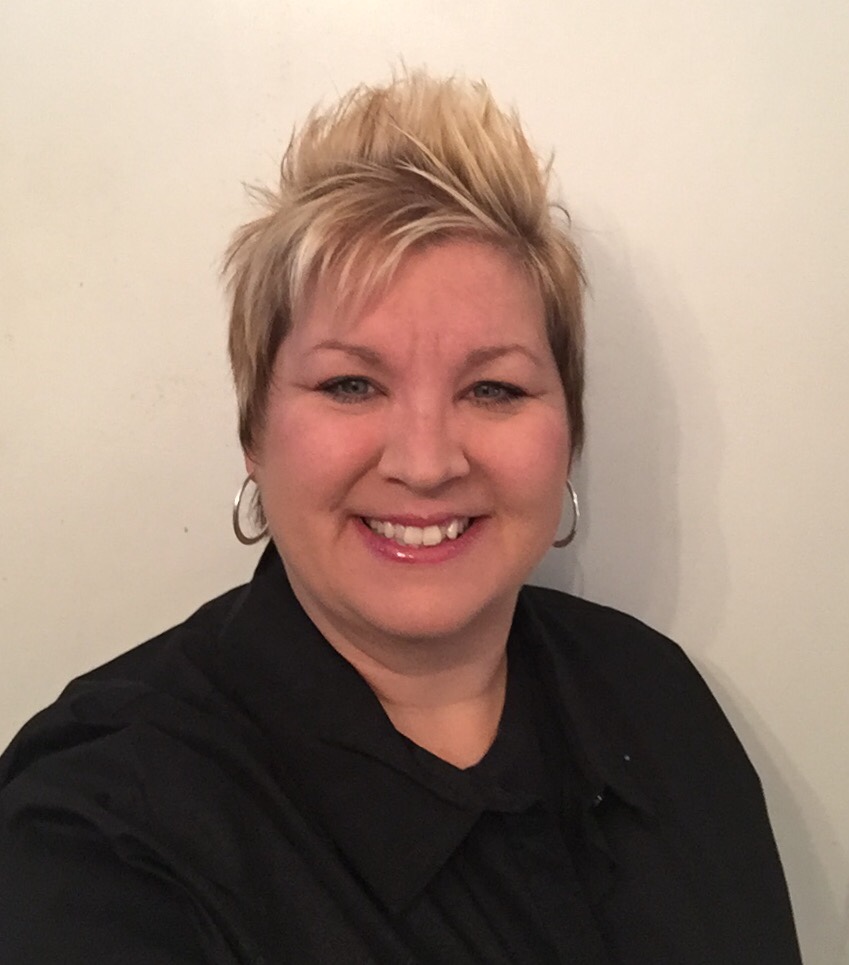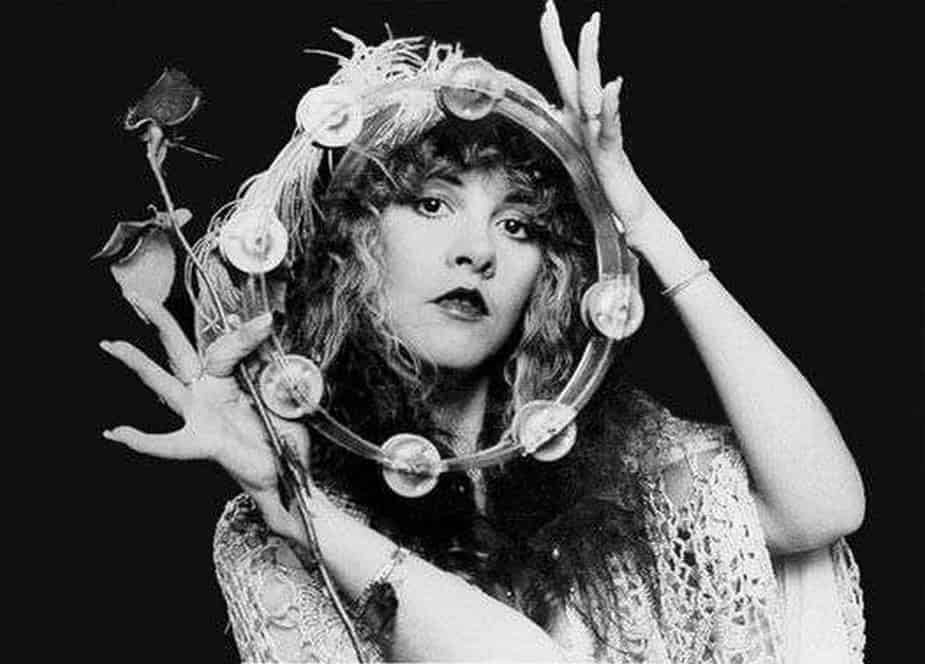Lillian Blair is a producer, engineer, and audio educator working out of the Seattle area. She is currently a staff engineer at The Vera Project Studios, where she chairs the Audio Committee, teaches studio recording and audio mixing and mastering. Lilian interned at the historic London Bridge Studios and received her degree in audio engineering from Shoreline Community College (A.A.A.S.), and in creative writing from the University of Washington (B.A.).
She offers a variety of services focused on the planning and creation of recorded music: songwriting, performance coaching, arrangement, production, and all aspects of audio engineering. She likes to think of herself as a Rock and Roll Fairy Godmother.
We caught up with Lilian to talk about her experience and work.
What was the first band you listened to growing up that became your “favorite”?
That would be Styx. I was definitely into dad rock as a kid, and to be honest I still am. Not really into Styx anymore, since I’ve moved on, but for a while that was all I’d listen to. Some greatest hits CD. I first heard them on a family road trip (never take your young children on a road trip) and, compared to the 90s pop country that my parents were mostly playing, it sounded interesting and complex and “new” and adult. Plus, Dennis DeYoung plays keys, and I’m a pianist, so there was that connection.
What was your first concert? Do you remember your reaction to it?
Again, Styx, at the Gorge Amphitheater in George, WA, which is the perfect name for a town. Kansas was opening and staying at the same hotel as us and helped my dad when a beach umbrella fell on him. Neither of us recognized them until they were on stage playing “Dust in the Wind.” Now that’s cool, but it certainly wasn’t as an eight-year-old. There were lasers and a bunch of people my dad’s age smoking. I thought it was cool and fun to be able to hear music live. The sheer noise of it (no earplugs for us). Seeing famous people, even far off. Singing along to the music that I loved.
How did engineering enter the equation?
I got my first taste of engineering in high school. I took an audio engineering class because my friends were taking it, and found it cool, though I didn’t get to do much engineering. My friends and I was in the house band, so I spent that class playing guitar while the other kids got to do the actual engineering. We did end up doing some home recording, and I even bought a bit of gear, including my first 57, fully intending on continuing with that. Then the band broke up. I ended up using the gear to make an EP that I have successfully scrubbed from the internet but put doing it professionally at the back of my mind for a few more years until I decided it was something that I loved and wanted to go into.
You are the Staff Engineer of the Vera Project in Seattle. Can you tell us a bit about what this center is and what it’s like working in the studio?
The Vera Project is an all-ages, youth-focused art center and music venue located in Seattle Center right across from KEXP, the world’s best radio station. We offer classes in engineering and other DIY crafts, such as screen printing, have volunteer opportunities for people to work shows, and are a way for young kids especially to get their start in live audio. We have members go to work at large venues in Seattle right out of high school because they already have a couple of years of experience running front of house in a 350 cap venue! It’s amazing!
The recording studio is one of the smaller programs. Lots of people don’t even know we have one, but it’s there, upstairs. We have an excellent live room, which is what attracted me to it in the first place, with lots of fun acoustic elements that I can play around with. An elevator shaft, a fun stairwell, an echo chamber in the form of the loading bay downstairs. We’re on the cheaper side as far as gear is concerned, but that’s not really something that bothers me. We have that great room, and almost as importantly we’re able to set up 32 inputs like the other professional studios in town. This means I can record the way I want to record, and give my artists a record that’s competitive, at least creatively, with the stuff they can get at higher-priced studios. This is perfect for young artists just getting their start and getting their first experience in a studio. And we still have good preamps and workhorse mics, just no vintage U47s.
You’re known for capturing drums with as many mics as possible. What led to this approach?
I went to school at Shoreline Community College and was introduced to studio multi-micing there. I think we topped out at your standard 12, though we did experiment with some interesting mic choices (front of kit mic, side of snare, kick drum tunnel), so I was already exposed to the idea of having fun and adding in more mics to be weird. When I interned at London Bridge Studios, also in Shoreline, that concept was kicked up. They introduced me to even more mic options, including the concept of putting up multiple room mics to capture the ambience as it moves through the space, extending the snare tail like you can get with compression, but without changing the dynamics of the performance. Plus, every acoustic space sounds different, just like every drum kit sounds different, so capturing that in interesting and creative ways gives you a sound that nobody else has, and in the days of samples that makes your work stand out.
Every bit of the drum makes sound. I don’t see people micing the underside of toms, but that head adds so many harmonics and resonance to the sound it makes the recording sound like the drum sounds in the room, rather than like you have your ear placed up against it. The front of kit mic (usually a 57 aimed at the snare) is another one that seems second nature to me, but people are always baffled by it. I measure it against the overheads, creating a quasi-Decca tree, and bus it with the spaced pair. It works really well with 414s, so you get the fullness of a large-diaphragm mic with the snap of a small diaphragm. I’ve done over-the-shoulder mics, but you have to worry about drummers knocking into them, and I’d rather avoid getting in the way of the performer.
You also like mic placement in out-of-the-ordinary spaces, like the elevator shaft. How do these sounds work into your mix?
Sometimes they’re mixed low, sometimes they’re mixed high, and sometimes they get cut altogether. Most of them are focused on making the snare drum sound cool, because when you listen to it that close mic sounds kind of boring. Toms are about the note (which is why you should tune them to be in the key of your song). Kick is about the thud and the power. Snare is about the uniqueness of the tone. If I put up weird mics, then I get an interesting tone nobody else has. Like the elevator mic. At Vera we have a wheelchair elevator that’s open-top, leading into our live room. It’s a rectangular shaft, and the metal sides are flimsy, so they vibrate, adding their character to the signal. It sounds kind of like an all-in 1176, without the weird dynamics, just the distortion and smoothed out since it’s sort of far from the drumkit. It adds a unique tail to the drums that really enhances the overall tone. I tend to mix that one pretty high, after some extreme EQing to get rid of that pesky high hat. Weird mics tend to get extreme EQing. Another fun acoustic quirk of Vera’s studio is our stairwell, in particular one corner that’s a very acute angle in an otherwise boxy landing. I like putting a Blumlein pair right in the corner (the mics know what they did), to capture the uniqueness of the sound as it bounces around in that uniquely shaped area. The Blumlein ensures that I get all the different idiosyncrasies while keeping it in stereo. I’ve done an Omni mic there, but it’s just not as cool.
Have you ever experienced any sexism as a woman in the industry?
Of course. Most of the professionals I know are, well, professional, and welcoming, and encouraging. They know the gender disparity in the industry is an issue and needs addressing, and one of the things everyone can do (aside from hiring more women) is to make sure the environment is exactly how they treat me: professional and welcoming, and encouraging. There are wonderful people in this industry and I have so much respect and gratitude for them and the opportunities and support they’ve given me.
Most of the sexism I experience comes from bands, actually. There are so few women who do what I do (I don’t know a single woman rock producer who works with bands in Seattle. Seattle! If you are one, let’s be friends!) so artists just aren’t used to the idea of working with women, and that includes women too. I do get work because I’m a woman, usually from parents who are more comfortable sending their teens to a woman than some dude, and of course the EQL directory, but I do get met with a lot of disbelief in the fact that I even have the pedigree that I do, let alone the ability to do what I do. Dudes in bands are worse, though. Far too many times I’ve had them walk away from me as soon as they realize I’m not going to sleep with them. I get it, some rock and roller chick comes up to you at a show, you’re immediately going to lizard brain yourself into believing it’s the 80s. No matter how I interact with them we’re not going to overcome that disappointment. There’s nothing I can do to control for that reaction.
Then there are the men who mistake professional admiration for sexual interest. Thankfully, none of them have tried anything. They’re professionals and act professionally. But I do feel like this assumption has hurt me, cost me connections and friendships. I don’t date in the industry, to the point of passing on relationships with people with whom I have a genuine (and mutual) attraction. The one piece of advice that was given to me by multiple successful women is to avoid appearing like I’m trying to sleep my way into a career. Not even not sleeping with people, but avoiding even the perception of it. Maybe that’s a relic of the past, just like all the dudes in bands who automatically think I want to sleep with them, but it’s advice that I follow. Kind of. I still dress however I want to dress. I like looking good. I’m naturally introverted, so it helps me get into character for going out and talking to people. But I still make sure to show up to events solo and deny myself the kind of personal connections that men seem to be able to have.
The worst though is that writing all this, I can’t definitively say that I’ve experienced sexism, or at least overt sexism, aside from a couple of instances of sexual harassment. Maybe it’s just Seattle, but everything is under the surface. I feel like I experience sexism, which is probably enough, but is that me being sexist against myself? There’s a lot of self-doubt around this subject. Is any of what I just wrote even real? Am I just expecting to experience something so I read into every interaction through that lens? Am I just making excuses?
You recently presented to the AES Diversity and Inclusion meeting. How did it go? What did you want to express to those attending?
I hated it, to be honest. I talked a lot about my experiences and what I said in the above paragraphs. Mostly I just talked about how to get more women into the industry. The cultural stuff needs to be said, because when it comes to getting more women in the industry everyone wants to talk about everything BUT the culture, which is so disheartening that I think it pushes a lot of women out, starting with the very start, with school and internships (I cried in the garage at London Bridge multiple times because of how people treated me). Most of my talk was positive, about inspiring girls and being proactive in mentoring young professionals and that most important of things, hiring women. But as I was doing it, knowing how important it was, it did feel like complaining, like I was risking my career by speaking up. That self-doubt I talked about earlier. Is this really real? Am I just deluding myself? Is anyone going to take me seriously, or are they going to write me off and decide I’m a liability because I’m willing to talk publicly about what I and other women experience? I still feel like I shouldn’t have done it. I haven’t heard one way or another what my industry friends think, so….
You recorded a band in the woods. How was that experience and what led to experimenting with outdoor sound?
It was really fun and powerful, especially since we infused everything with magic and witchery. I’ve actually done a couple of projects in the woods with that particular artist. The first was a ritual where we had about a dozen people participating, and the second was the album. We went out there because the band asked if we could go there. I could have said no, and convinced them to go into a studio, and we would have made a good record, but I was very much in “Say yes to everything” mode so I said “yes” and then set to figuring it out. It was a challenge, but you never should shy away from a challenge. We ended up using a portable battery pack, a laptop, and an eight-channel interface. I did not get to put up my 16+ drum mics, but that’s just a sacrifice I had to make to do something adventurous. We DIed the guitar, and used mics for the rest, including distance mics set on Omni to capture the ambience of the forest. Now that I think of it, I should have kept the mics on cardioid and faced them away from the artists, but whatever. Maybe the next chance I get to do a record in the woods.
My favorite memory from that was one of the songs we did at night, around the campfire. We’d timed the recording to coincide with the new moon, for witchy reasons, and being away from the city we could see the stars. There was a hill nearby so for one particular song I had the artists face the hill and I placed a lantern behind them (the campfire wasn’t bright enough), projecting their shadows on the hill. They danced as they sang, seeing their shadows move. Very Brocken Specter and super cool to watch. I think it helped them get into it more. Both songs we did around the campfire hit that magic(k) take exactly at midnight. Did I time it that way? Maybe? Knowing we’d go about half an hour from setup to them getting into it enough to give me what I needed. Was it witchcraft? Also maybe.
Through Gear Fanatix, a site for underrepresented voices in audio, you have written articles about the gear you’ve both enjoyed working with or been frustrated with. What has it been like to review various pieces?
It’s been fun. I have thoughts about everything, and just getting to type them out and go on tangents is something I enjoy. Everything has something good and something bad about it, even the stuff that I love, so making sure there’s a balance is important. I always love reading the bad in articles. I figure good is good, but the bad is where you’ll learn whether or not the gear is worth buying. I’m working on a review of iZotope’s Neutron, which is the first piece of gear/software that I was actually given, and that’s a tough position to be in. I kind of want to stick to demos and loans, to be honest. Free stuff is fun, and there are no strings with this, but it definitely does put pressure on the review. The pressure for me is to be as honest as possible and to really make sure that the bad is put front and center because there’s some stuff about that plugin that I really hate. And stuff that I love. Like with everything. As a tease, how is it that there’s a plugin that’s going to be on every mix I do going forward where I absolutely hate its key, defining, innovative features? Does that make it just another plugin bundle? Check out GearFanatix.com to find out!
What is one piece of dream gear? Why?
I don’t really have a piece of dream gear, to be honest. If I were opening a studio, I’d want a Rupert Neve Designs 5088, because why not, though I might also go full 21st century and get an Avid S6, but that’s all monopoly money and not something I’m interested in pursuing. I have a hybrid setup for my mixing, having jumped on the summing box train. I think having your stereo bus processing analog is a nice way to keep your mixes flexible while also being able to concentrate your budget into a few pieces of high-end gear that will affect your sound much more than getting a rack full of cheap compressors and EQs. Since I’m only allowed to pick one, I’m going with the API 2500+, the one with the wet/dry knob. I’ve used the software version, and it’s incredibly versatile and sounds amazing. A bit out of my budget, though. The Tegeler Crème is fun too, and a little more justifiable cost-wise. It’s a stereo VCA compressor with a passive high and low-shelf EQ that’s very transparent and, well, creamy. Perfect (and designed) for stereo bus processing. I’ve fallen in love with diode compressors too, like the 33609, even though they’re too vibey to be my sole bus compressor. I’d get one as my second, alternate bus compressor, though. Ok, that’s five pieces of gear. Do you think I might actually like this stuff?
How has COVID affected your job this past year?
I don’t want to get maudlin, but significantly. I record bands. If I can’t go to shows to talk to bands, I can’t find new bands to record. If bands can’t play shows, they can’t afford to hire me to record them. If studios are closed, bands are going to record themselves. This past year my work has been almost exclusively mixing and mastering. Thankfully, artists may want to do their own music, but still realize there are things for which they need a professional. I’m even doing some distance producing. I wrote an article about this, actually. It mirrors mixed revisions, in that there’s a back and forth with me giving the artist notes on the arrangement, and then making the adjustments until we’re both happy. Then I get to put it all together and they tell me what they want until we’re both happy. It works, though it takes a while, and leaving the recording schedule up to the artist does have its downside. When you’re in a studio, you’ve gotta get it done, and your whole focus is on creativity. A good producer will be able to keep those creative juices flowing throughout and keep things from getting monotonous and draining. I can’t do that if we’re communicating over texts and emails. So the whole process slows down, which in itself can be demoralizing. The projects still get finished, but I can’t wait to get back into the studio: be in a room with people, feel the agitation in the air, smell the sweat, get exhausted but keep pushing because we know that the next take is gonna be the one.
If you could talk to yourself from ten years ago, what one piece of advice would you tell yourself?
Trust your gut. Don’t assume people know best just because they’ve been doing this longer than you. Everybody is making it up as they go along, changing their approach, learning from their mistakes. There are stories behind this but you don’t get to hear them.
Follow:
Watch “Proof in Music” Episode 2 featuring Lilian Here.
LilianBlair.com
Instagram @lilinblair
Facebook @lilinblair



